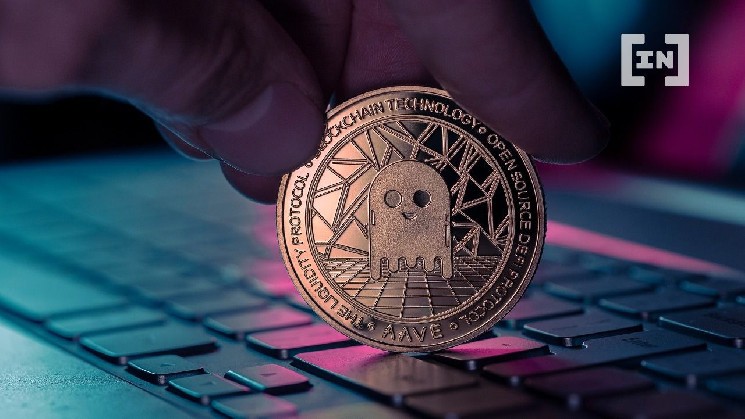Aave GHO Stablecoin Proposal Has Merit But Also Carries Risks

Aave GHO Stablecoin: Stablecoins have become a big part of the cryptocurrency and decentralized finance industry. Julia Magas breaks down this latest offering.
Despite recent setbacks affecting UST and other algorithmic stablecoins, interest in these products remains fairly high. Aave, a leading DeFi protocol, will introduce a fully collateralized pegged currency on the Ethereum blockchain.
Aave: A New Stablecoin
The Aave community, in the form of Aave Companies, has put together a new proposal to introduce support for a different digital asset. More specifically, that new asset would be a stablecoin, dubbed GHO, to help improve various key features of Aave’s lending platforms. Holders of Aave’s AAVE token were able to respond to this proposal and offer comments, support, concerns, and criticisms. Interestingly, 99% of the community seemed in favor of this idea, which is a tad surprising.
No one can deny the growing popularity of stablecoins within the cryptocurrency industry. Assets like Tether (USDT), USD Coin (USDC), Binance USD (BUSD), and other assets continue to grow in market cap and popularity. Users can exchange these pegged currencies for nearly all other cryptocurrencies on both centralized and decentralized exchanges. In addition, these three stablecoins are backed by hard assets, unlike their algorithmic counterparts, which have seen a fair few issues.
Algorithmic Stablecoin Cons
Algorithmic stablecoins are not backed by cash reserves or precious metals. Instead, they retain their peg to the US Dollar by keeping cryptocurrency reserves. As cryptocurrencies are volatile in nature, it is a very precarious balancing act. The recent collapse of Terra’s UST, USDD briefly losing its peg and dropping to $0.93, Fantom’s DEI de-pegging, and Solana’s NIRV losing over 85% of its value all confirm the algorithmic approach is very risky. As such, demand for more secure and – frankly, stable – pegged currencies continues to rise. Interestingly, the GHO proposal involves a mainly algorithmic currency, albeit backed by a basket of other digital assets.
Following the successful proposal, GHO will be offered to Aave users by minting it against their supplied collateral. Users can mint GHO through various supported crypto assets, and GHO holders will continue to earn interest on their supplied collateral. That makes GHO a yield-generating stablecoin, yet the team has to ensure it retains the peg to the US Dollar at all times.
Can GHO Succeed?
Given the algorithmic nature of GHO, there will undoubtedly be some questions regarding its viability. It is logical for Aave to focus on letting users borrow against their collateral, as it is a decentralized lending platform. Introducing support for a native stablecoin makes sense in this regard, but only if GHO can support its $1 price peg without skipping a beat. As we have seen with other algorithmic stablecoins, that is easier said than done.
Under the hood, users can mint $1 of GHO by supplying their Aave collateral. There will be a dedicated collateralization ratio to acquire GHO, although those details remain unclear at this time. In addition, if a user repays their borrow position – or, in the worst case, faces liquidation – the protocol will automatically burn the user’s GHO balance.
Furthermore, the interest payments on GHO balances will be sent to the AaveDAO to generate more revenue for the community and beef up the DAO’s treasury. That same DAO will determine the borrow interest rates for GHO, although the stable rate may fluctuate depending on market conditions.
Overall, the proposal has potential, but there are many aspects that need to be figured out along the way. Introducing GHO may pose a real risk to Aave and its position in the decentralized finance industry due to it borrowing some elements from other algorithmic stablecoins.







 Bitcoin
Bitcoin  Ethereum
Ethereum  Tether
Tether  USDC
USDC  Dogecoin
Dogecoin  Cardano
Cardano  TRON
TRON  Bitcoin Cash
Bitcoin Cash  Chainlink
Chainlink  Polygon
Polygon  Litecoin
Litecoin  LEO Token
LEO Token  Dai
Dai  Ethereum Classic
Ethereum Classic  Stacks
Stacks  OKB
OKB  Cronos
Cronos  Cosmos Hub
Cosmos Hub  Stellar
Stellar  Hedera
Hedera  Maker
Maker  Monero
Monero  Theta Network
Theta Network  Algorand
Algorand  NEO
NEO  Tezos
Tezos  Synthetix Network
Synthetix Network  Gate
Gate  EOS
EOS  KuCoin
KuCoin  IOTA
IOTA  Bitcoin Gold
Bitcoin Gold  Tether Gold
Tether Gold  TrueUSD
TrueUSD  Enjin Coin
Enjin Coin  Zilliqa
Zilliqa  0x Protocol
0x Protocol  Qtum
Qtum  Ravencoin
Ravencoin  Siacoin
Siacoin  Holo
Holo  Basic Attention
Basic Attention  Dash
Dash  Zcash
Zcash  Decred
Decred  NEM
NEM  Ontology
Ontology  Waves
Waves  Lisk
Lisk  DigiByte
DigiByte  Numeraire
Numeraire  Status
Status  Nano
Nano  Pax Dollar
Pax Dollar  Hive
Hive  Steem
Steem  Huobi
Huobi  OMG Network
OMG Network  BUSD
BUSD  Ren
Ren  Bitcoin Diamond
Bitcoin Diamond  Bytom
Bytom  HUSD
HUSD  Kyber Network Crystal Legacy
Kyber Network Crystal Legacy  Energi
Energi  Augur
Augur